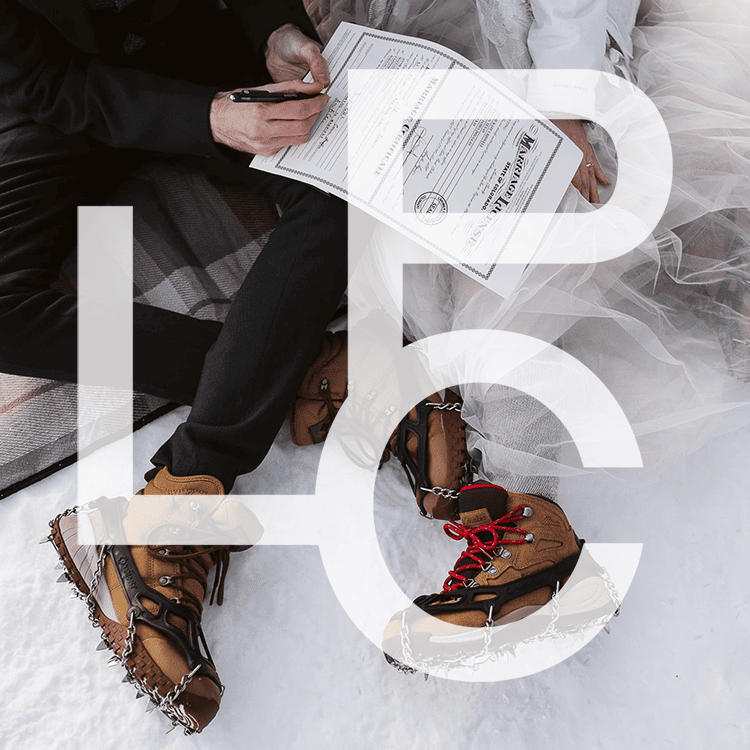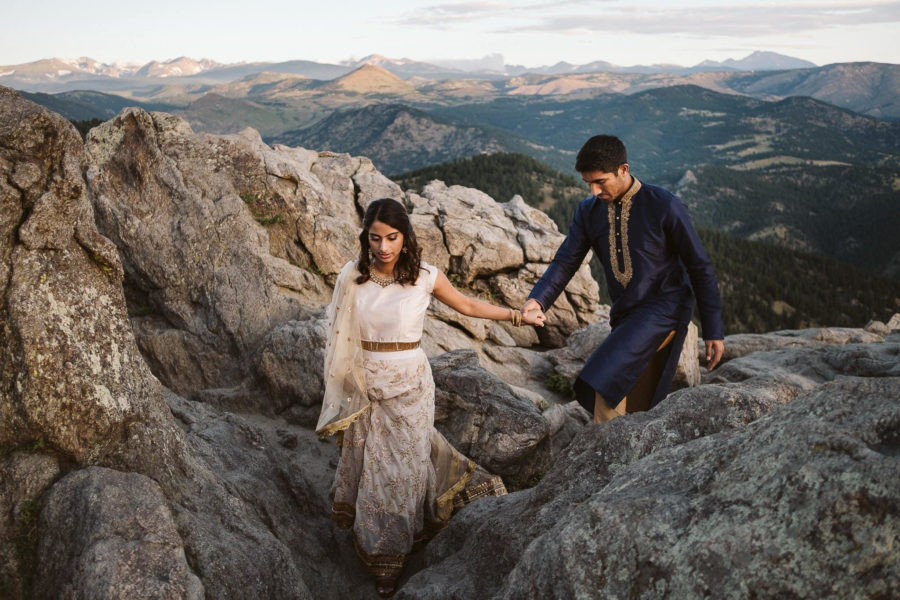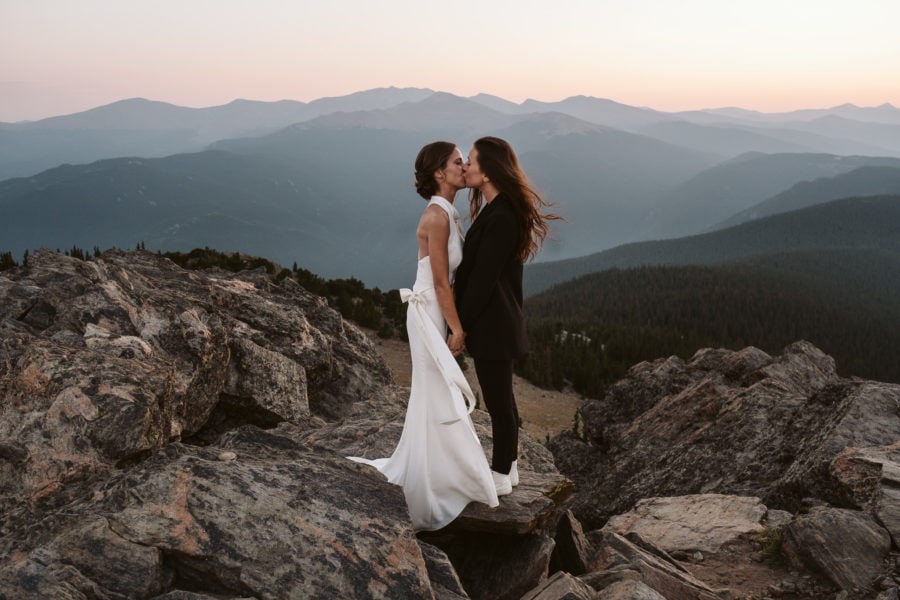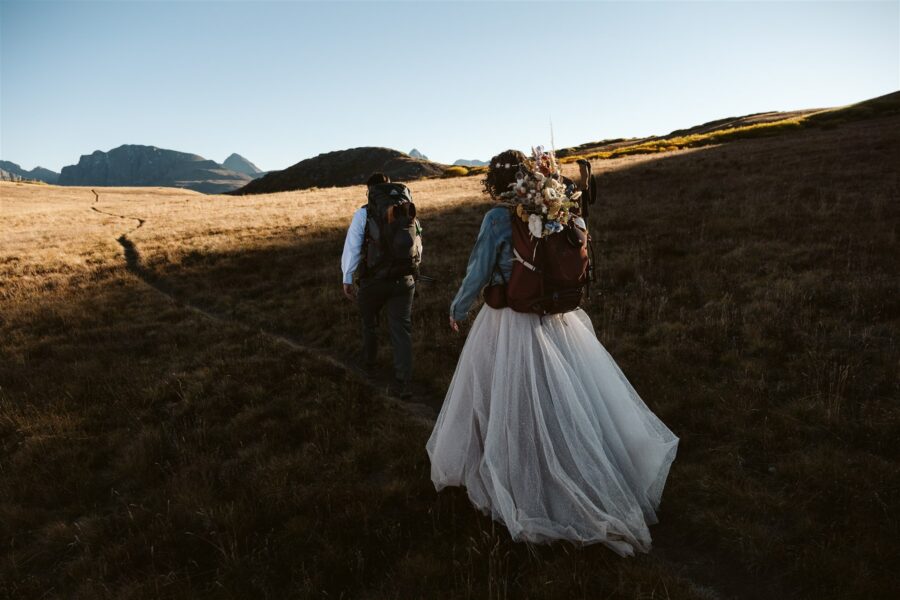Adventure Elopement Gear
Before we get into my elopement gear recommendations, I wanted to define what I mean by “adventure elopement.” There’s no right or wrong way to define it, but I like to think of an adventure elopement as a wedding celebration where you’ll be spending at least part of the day in the wilderness, away from easy access to conveniences like running water and electricity. Sometimes that means hiking into the backcountry, other times it’s driving a Jeep up a 4×4 mountain pass road, or snowshoeing into a winter wonderland. Either way, you’ll need to be prepared with the right gear so that you can handle any surprises without stress.
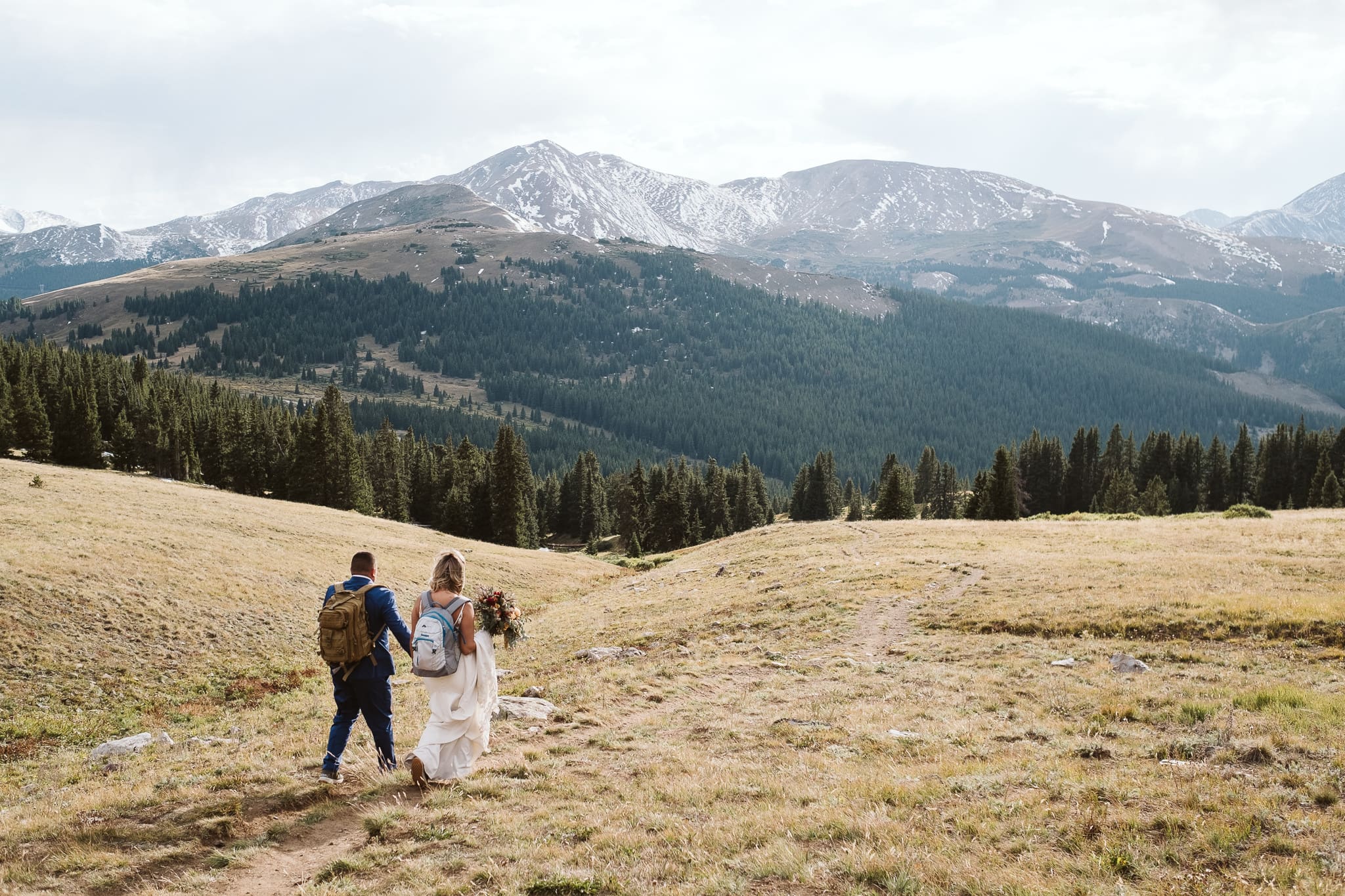
Why do I need special gear for my adventure elopement?
If you’re already experienced adventurers, you probably have much of this gear already. But for many couples, their elopement day is the first time they’re heading into the backcountry on a big hike or adventure. Having the right gear makes all the difference in how you experience your elopement day.
There’s nothing worse than being stuck in a midsummer hail storm without a rain jacket, or wanting to sit down to eat a picnic lunch after a long hike, but having nowhere to sit on the ground without getting your white wedding dress covered in mud. The right gear will make your elopement day easier – there’s no reason to carry heavy gear in a paper bag from Whole Foods when you could keep your hands free with a lightweight backpack!
Elopement packing list
Wondering what to pack for an adventure hiking elopement? Keep a packing list handy on your phone, so that you can feel confident you’re not leaving anything important behind before leaving your heading out on the trails. If you’re getting ready for your elopement at an airbnb, spend some time on putting together all your gear before getting dressed, so you don’t have to stress last minute when your photographer is there.
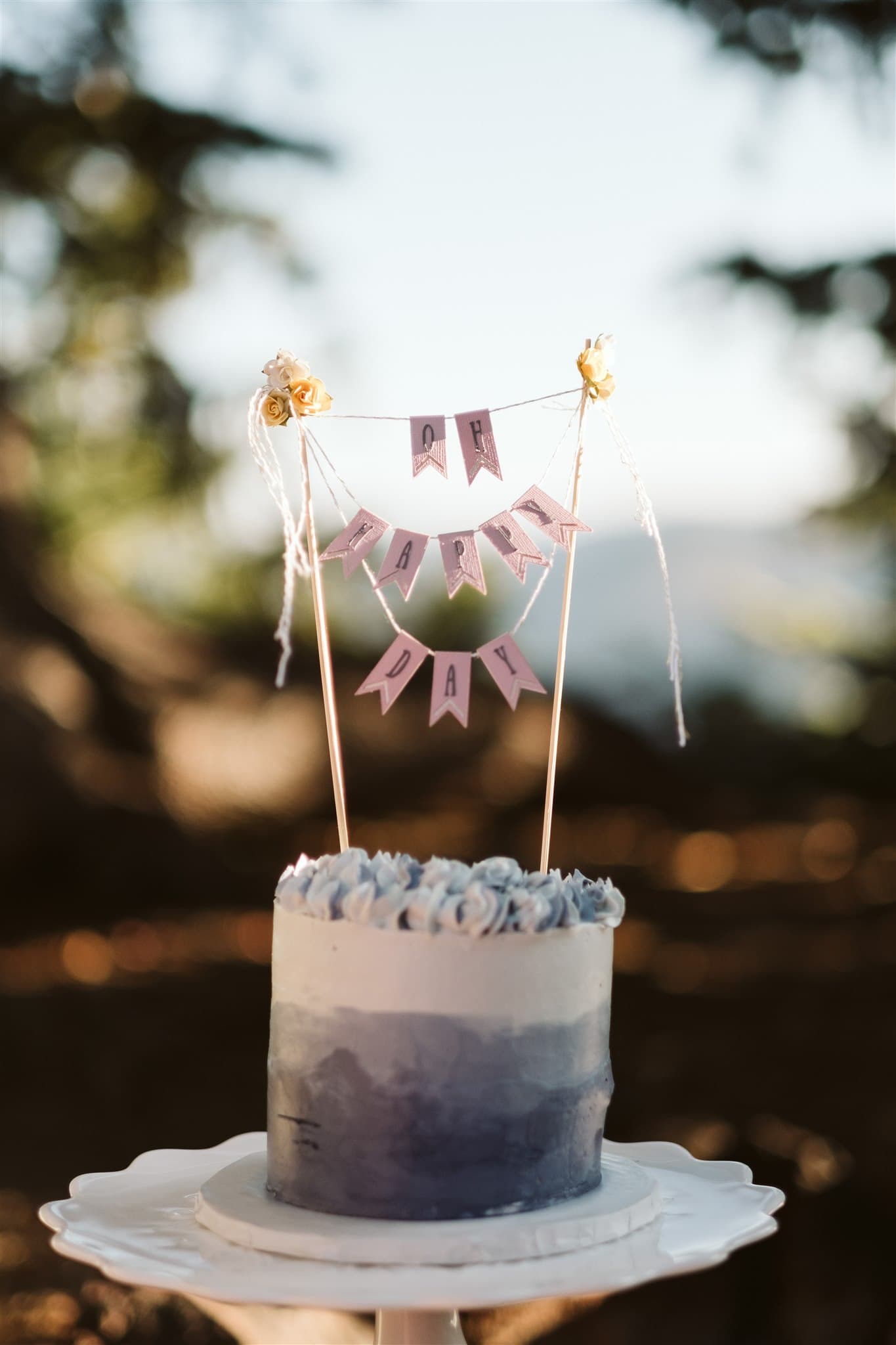
Elopement gear essentials
- Marriage license and pen with black ink
- Printed permit if required
- Vows
- Rings
- Bouquet(s) and/or boutonniere(s)
- Water
- Snacks and sweets
- Champagne or other celebratory beverage
- Backpacks
- Picnic blanket
- First aid kit
- Sunscreen and bug spray
- Toiletry bag
- Pocket mirror
- Hair brush
- Deodorant
- Makeup for touchups
- Bobby pins and/or hair ties
- Tide stick for stains
- Mini lint roller
- Bathroom necessities
- Navigation (paper or digital map)
- Portable speaker
Extra gear for winter elopements
- Microspikes
- Hand warmers
- Extra wool socks
- Extra layers
- Hats, mittens, scarves
- Thermos with hot beverage
- Trekking poles
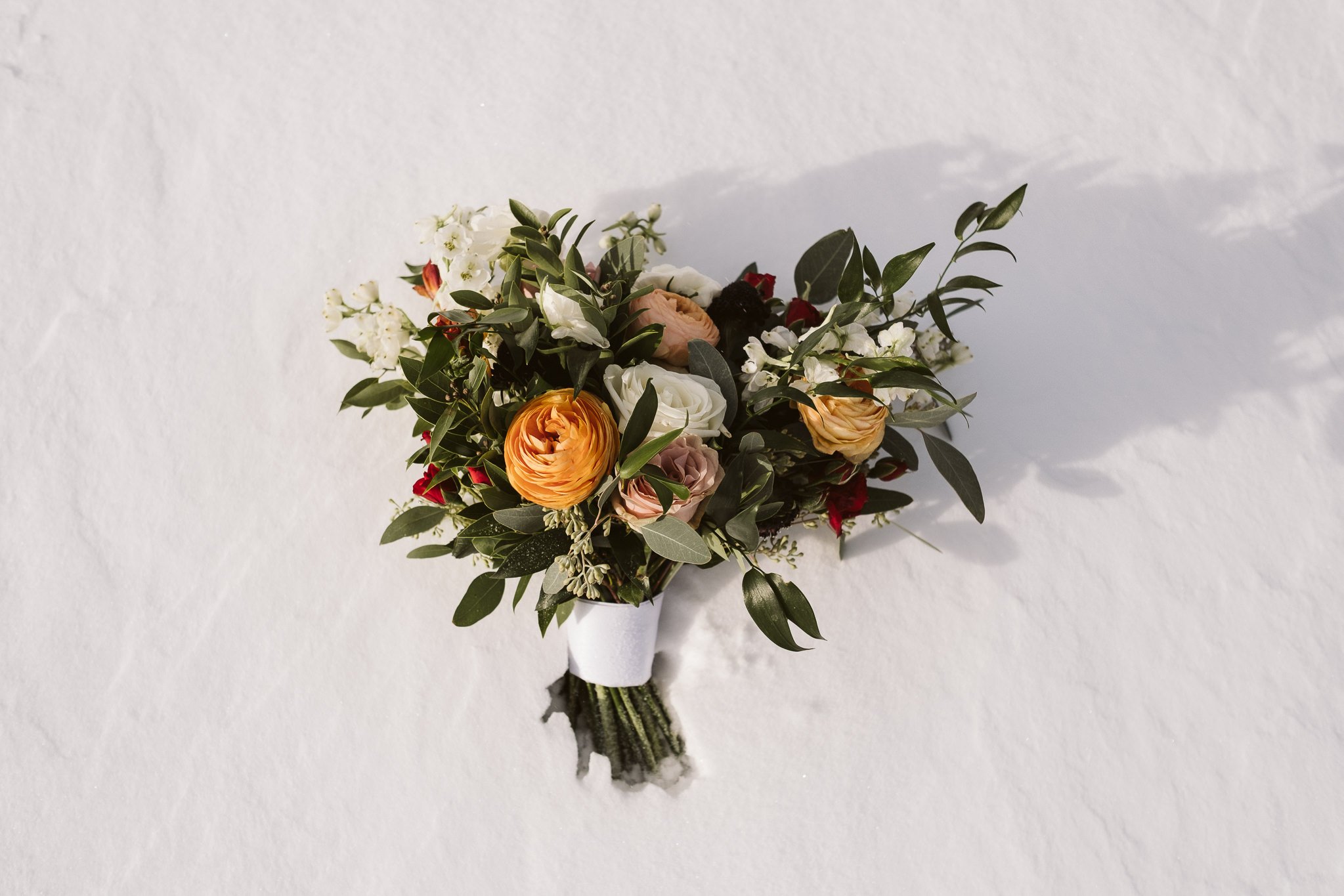
Essential gear recommendations for every elopement
I legally have to tell you that some of the links in this post are affiliate links and I get a small kickback if you buy products from them. But I promise this post is way more about me recommending my favorite gear that my couples and I have used for real elopements and adventures than it is about me making money.
Backpacks
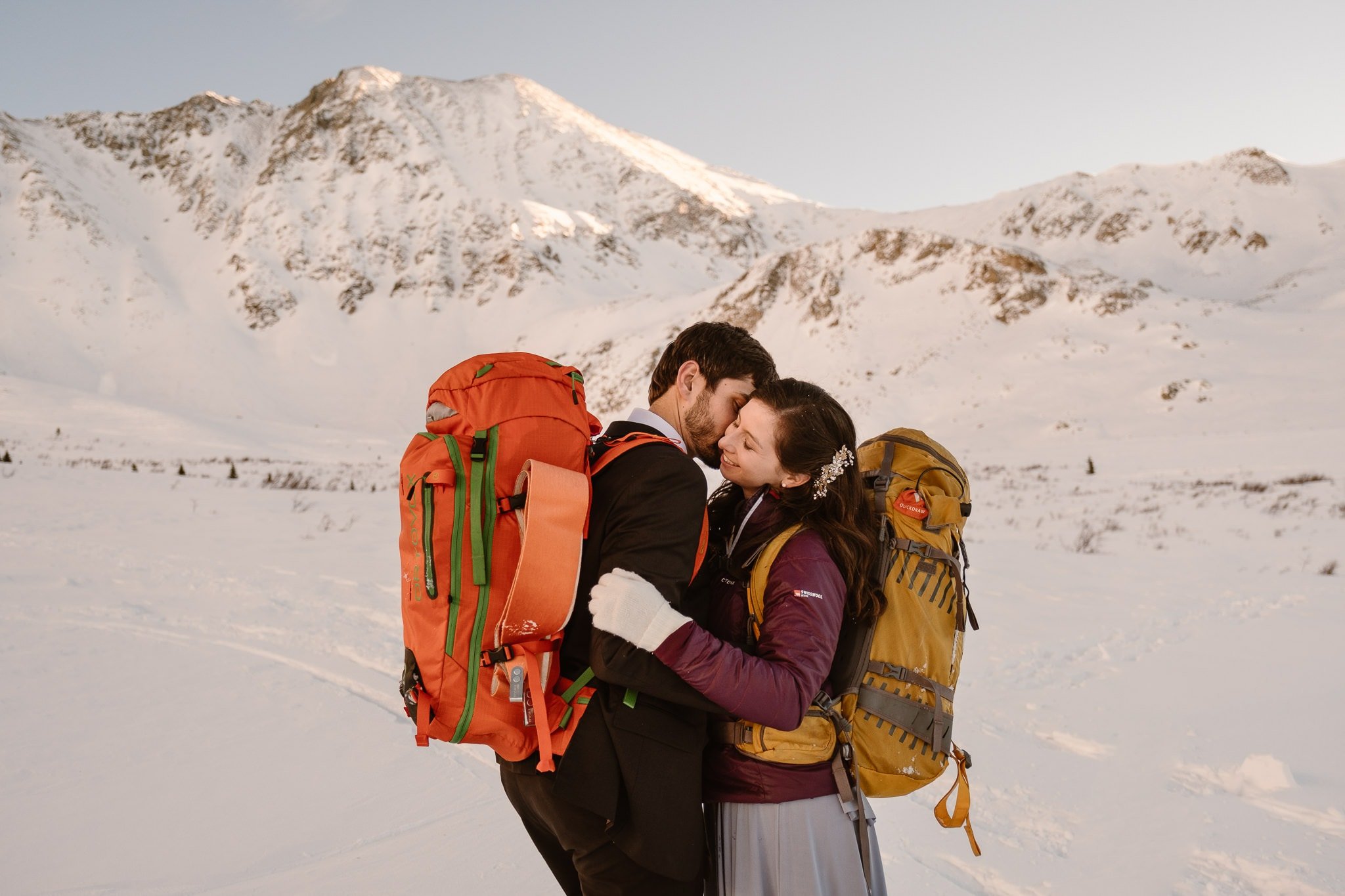
The first and most important piece of gear for your hiking elopement is a good backpack. Even if you’re not hiking far, you’ll be carrying your marriage license and vow books, snacks and beverages, extra layers, toiletries, and enough gear that you’ll be happy to have the weight distributed evenly on your back. For short hikes, it’s often enough that one partner wears a backpack, but for longer hikes you’ll each want your own daypack so that you can have easy access to your own hydration reservoirs.
If you’re wearing your wedding attire while hiking, you likely just need a daypack. REI has a fantastic guide on how to choose a daypack that I recommend you check out. If you’re planning to hike up in normal clothes and change into your wedding attire at your destination, you might want to consider a larger backpack meant for overnight trips, so that your attire has plenty space without being crumpled up. Once again, REI has a great guide on how to choose a backpack.
Things to look for in a backpack for your hiking elopement:
- Easy access to water via an internal hydration reservoir pocket, or side pockets for water bottles
- Side pocket with adjustable straps for tying your bouquet to the outside of your pack so you can hike with your hands free
- Cute colors and style to match your outfits – you’ll see your backpacks in many of the photos from your elopement
- Something you’ll use again for future adventures
My favorite backpack brands:
- Topo Designs – Topo Designs is a Colorado-based company, with a flagship store in Denver and locations in Fort Collins and at the Denver airport, plus of course their online store. Their backpacks have a unique retro look – I’m especially a fan of the Klettersack and their simple Daypack.
- Fjällraven
- The Fjällraven Kånken is a classic – it was my daily school bag as a kid back in Norway! I now use it as my everyday “purse” to carry a water bottle and snacks on short hikes and when driving around Colorado.
- Because I’m a bit of a Fjällraven addict, I also have their Kånken No 2. laptop pack, which does double duty as my laptop bag when going to coffee shops (pre-pandemic, when that was a thing we did), and also as my camera bag for elopements with shorter hikes.
- Lastly I also have the Totepack No 1. which is the perfect convertible shoulder bag that can be worn as a tote or as a backpack. It’s my go-to for riding my bike to the farmer’s market!
- Osprey
- The Osprey Daylite Plus Pack is the exact backpack I use for most of my shorter hikes and elopements. It’s lightweight, has room for a hydration reservoir, and fits my camera gear, snacks, and extra layers without problem. It’s about to be discontinued though, so it’s possible this exact pack won’t be available by the time you’re reading this.
- For longer hikes and backpacking trips, I use an older Osprey Viva 50 pack that’s been discontinued, but this Osprey Aura 50 is super similar. It’s big enough that I carried my own tent, sleeping bag, and everything else I needed for 3 nights at Havasu Falls, but small and lightweight enough that I’ve also used it for daytrips in winter when I want to pack extra layers and strap snowshoes to my pack.
- Gregory
- Deuter
Elopement Footwear
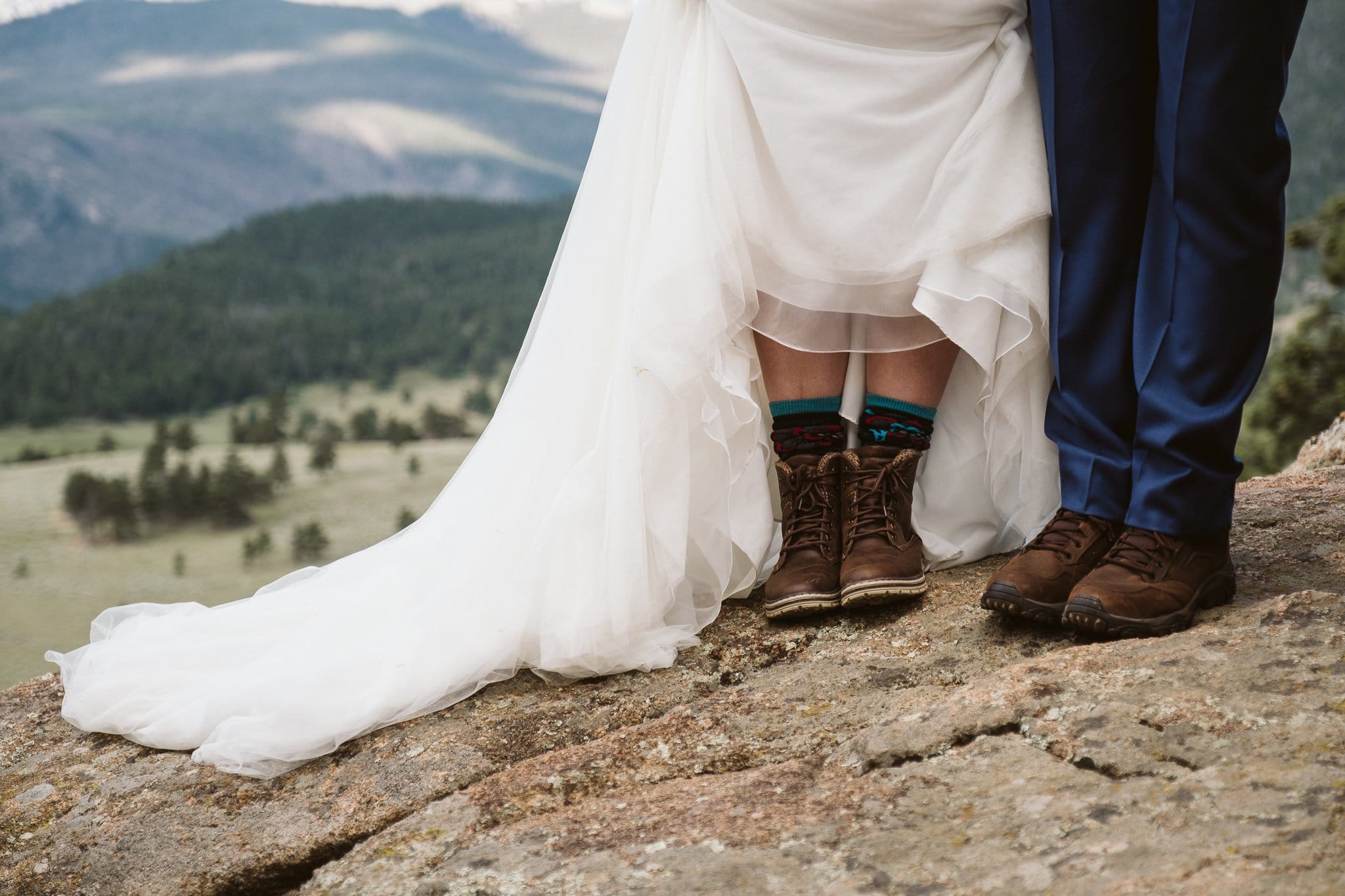
Your choice of elopement footwear is one of the most individual decisions, and comes down to the landscape you’ll be in, how far you’re hiking, the time of year and conditions you expect to encounter, and of course style. Many couples choose to invest in a good pair of hiking boots (or use their favorite worn-in pair), while others prefer something more lightweight like sneakers or sandals.
Whatever you decide on for footwear, it’s important that you wear in your shoes before the elopement. And that means wearing them outside on similar trail conditions, too, not just around your living room. You do not want to start your elopement day with getting blisters because you wanted to wear a brand new pair of cowboy boots on the trail.
The best footwear for adventure elopements all have a few things in common:
- Traction. No matter the conditions, you want shoes that have enough traction underneath that you can comfortable walk on grass, rocks, and other surfaces without slipping and falling. Men’s dress shoes are notoriously bad for this, as they’re completely smooth underneath. The rougher the sole, the more comfortable you’ll feel when outside in the elements.
- Comfort. You’ll be wearing your shoes all day, so make sure they fit well without pinching – or on the opposite of that, with too much room for your feet to slide around in them. Always try on shoes in person, or order online from a store with a flexible return policy.
- No heels. Seriously. It doesn’t matter how cute those low-heeled ankle boots looked in the dressing room, if they make you worry about spraining an ankle the second you leave the trailhead parking lot and head out into the mountains. The more confidently you can move around, the more fun you’ll have – and the better your photos will turn out!
My favorite footwear brands:
- Kodiak Boots – The Kodiak Original All Season Boots are my personal favorites when I want to look cute while hiking, and I’ve worn the heck out of my pair in the three years I’ve had them. Made of leather, they take a few miles to wear in and fit to your feet, but after that they’re super comfortable and fit like a glove. I’ve easily put 1,000 miles on my pair, and while they’ve gathered some scuff marks over the years, they still look great after a fresh boot shine. They’re a bit heavier than my Merrell’s, so I don’t wear them when it’s hot out.
- Danner Boots – Danner makes incredibly high quality leather boots that will last for years and years.
- KEEN
- Planning an elopement where you might have to cross a river, wade into a creek, or hang out at the base of a waterfall? I’m a big fan of my KEEN Newport H2 Sandals, which unlike Chaco and Teva are more closed around the toes – perfect for me since I have a tendency to stub my toes on everything. I’ve worn these for a 10 mile hike with multiple water crossings, and they stayed comfortable all day despite being wet most of the time.
- These KEEN Chelsea Boots would be super cute for a winter elopement where you don’t expect to step off trail and into deep snow. (Always go with higher boots for those!)
- Chaco – Chaco are best known for their sandals, and many of my hiker friends and couples swear by them in summer. I personally can’t stand having the strap between my toes, but to each their own!
- Teva – Teva is also known for sandals and water sport shoes, but have some super cute boots as well like these ankle boots.
- Merrell – In winter, I wear the Merrell Thermo Chill mid-height boots for all my hikes. I usually wear gaiters too though, which helps keep snow out of my boots. Since gaiters don’t look the best with wedding attire, I’d recommend going for a higher pair of boots for your elopement.
- Sorel – Sorel are the perfect high winter boots to wear with a wedding dress. I bought my Sorel Joan of Arctic boots my first winter in Colorado, and they still look great ten years later!
Socks
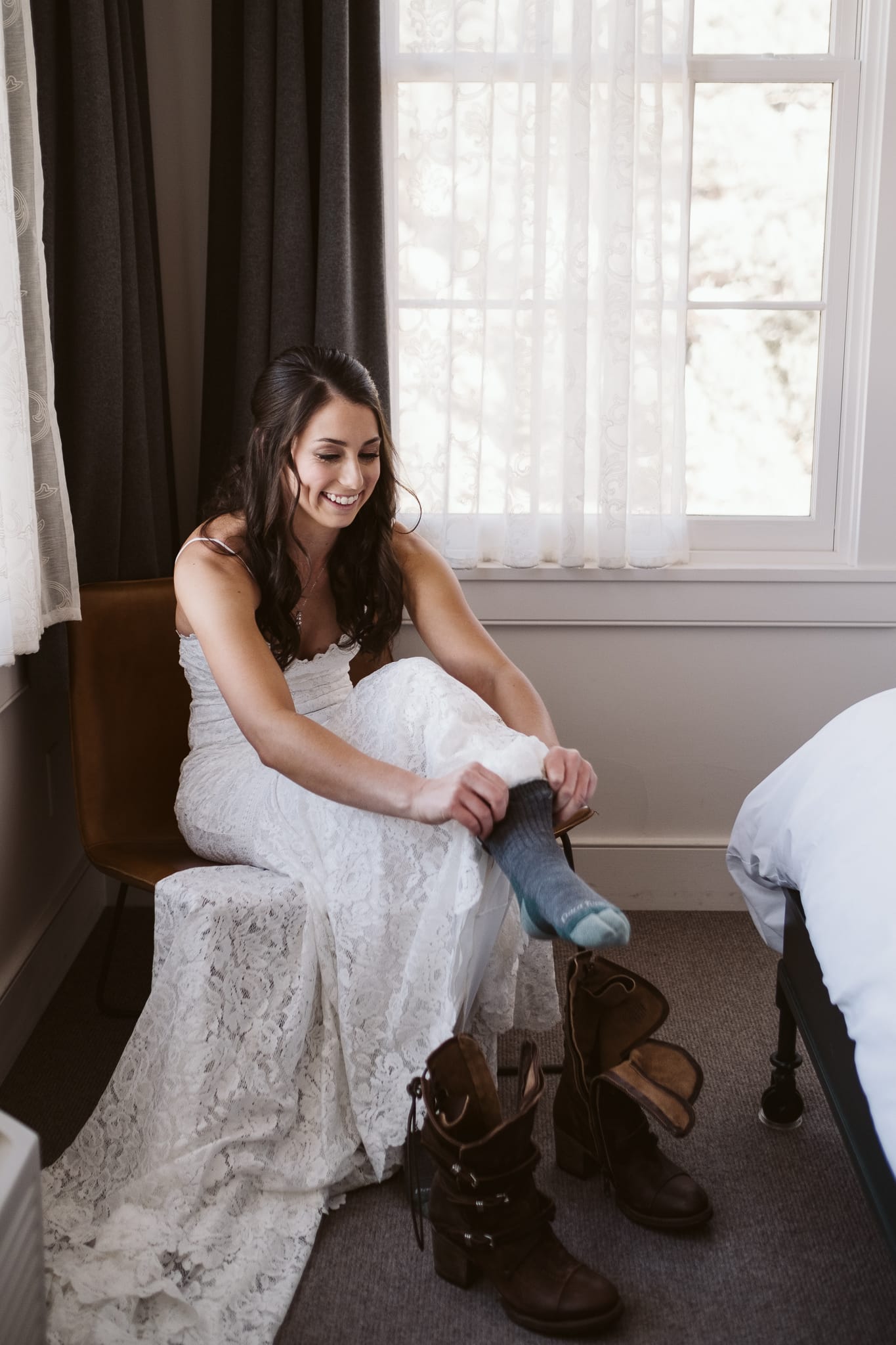
Socks seem like a trivial piece of gear, but nothing ruins an outdoor adventure faster than cold feet. Wool socks will always beat other materials, as they wick sweat away from your feet, and keep you warm in any conditions. Socks with cushioning will help keep your hiking boots comfortable all day. And as a bonus for winter elopements, wool socks don’t get cold when wet, so you’ll stay warm even if snow ends up inside your boots. Always pack an extra pair of socks in your backpack as well, so you can change into dry socks if needed.
My favorite wool socks:
- Darn Tough – Darn Tough socks are made in Vermont, and they come with a lifetime guarantee, which makes them absolutely worth the higher price since you can get a new pair for free if you wear holes in them. I personally prefer their Lifestyle socks over their Hiking socks because they have less cushion, but I know lots of people swear by the cushioned socks to keep their feet from feeling tired when hiking. (Also the Lifestyle socks have cuter patterns..)
- Smartwool – Smartwool is a classic for a reason. While they don’t offer the same guarantee as Darn Tough, they’re durable and high quality, come in tons of different styles, and will keep your feet warm in any conditions.
Underlayers
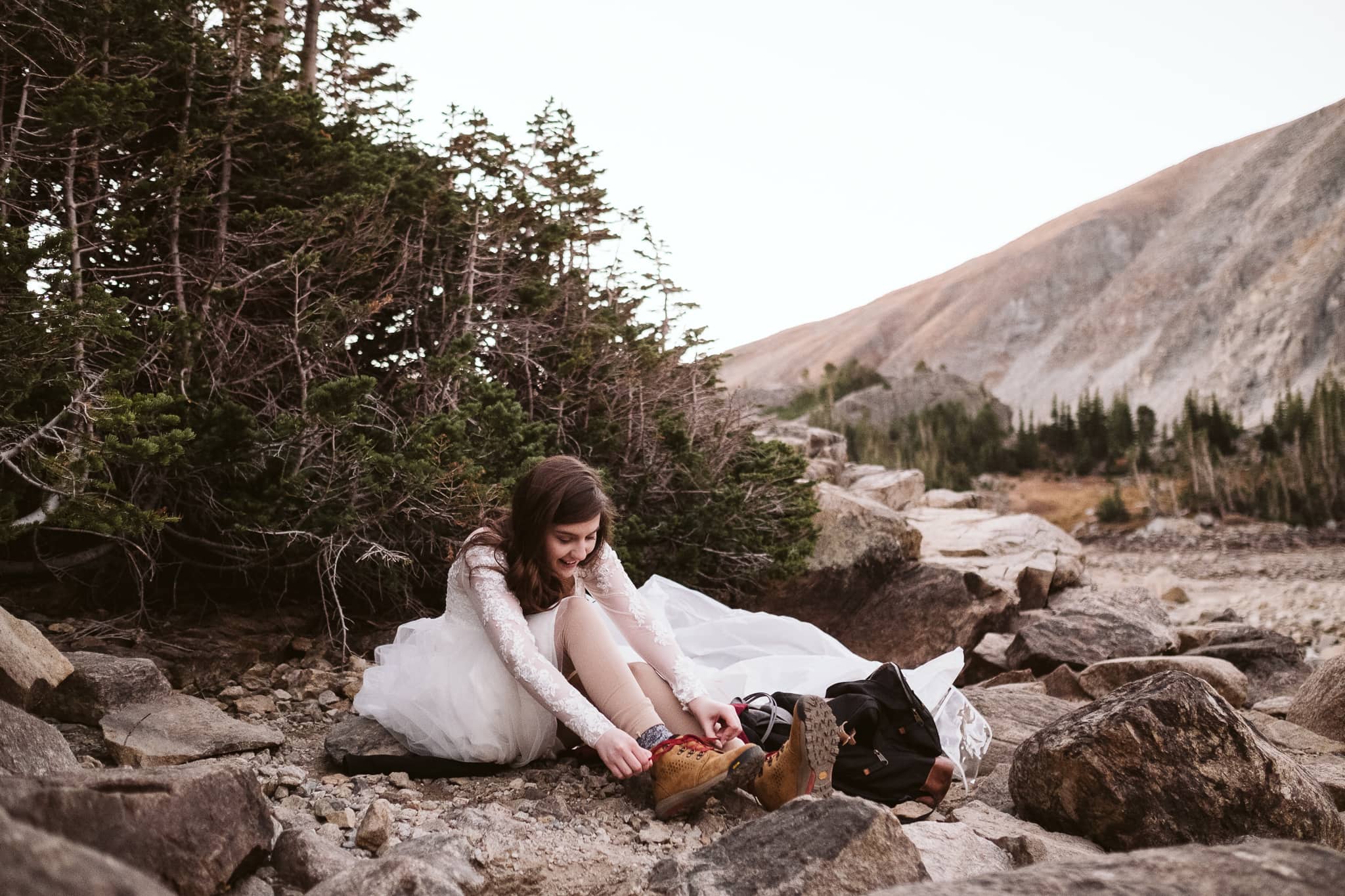
Let’s face it: most wedding dresses are not made for cold weather. So what’s the best way to stay warm for a winter elopement without adding bulky layers? Get a pair of nude-colored fleece leggings to wear underneath your dress! These are brilliant for invisibly adding warmth. You don’t want dark leggings or tights under a white dress, as they’ll show through the fabric. Look for a pair that matches your skin tone, and no one will ever know those aren’t bare legs peeking out in your photos.
Wearing a suit in winter? Consider adding a merino wool baselayer underneath the suit to keep you warm. If you’re going this route, I recommend buying your baselayer first so that you can wear it for suit fittings, and make sure the suit isn’t too snug.
My favorite underlayer brands:
- Smartwool – Smartwool is based in Steamboat Springs, and was founded by two ski instructors on the simple idea that they wanted to stay warm for longer while on the slopes. I’d say they’ve accomplished that!
- Icebreaker – Icebreaker makes sustainable merino wool base layers, and I admire their company’s transparency policies about where their wool is grown.
- Kari Traa – Kari Traa is my personal favorite for merino wool base layers, but I’m definitely biased as a Norwegian who watched her taking the gold in freestyle skiing at the 2002 Olympics before retiring and starting the clothing brand. But I digress! With colorful designs, these might not be the most subtle layers to wear under a wedding dress, but I own the Rose Baselayer set in three different colors and wear one to every winter hike and elopement, so I had to include them here.
- REI Co-op – A more affordable option than the other brands, but a great option for simple colors and clean designs.
- Nude fleece leggings – There are dozens of brands selling different versions of these on Amazon. I’d stay away from any that claim “compression” – you want a pair that will be comfortable while hiking. The fashion industry is still defining nude skin color as White skin, and this listing is the only one I’ve found that also has mocha and brown options.
Jackets and cover-ups

If there’s any chance you’ll experience cold weather on your elopement day, you want to have a warm jacket handy. Colorado elopements at high altitude can often be cold, even in the middle of summer. It’s not unheard of to experience temperatures in the high 30’s at 12,000ft, even if it’s a balmy 90 degrees down in Denver.
When buying a jacket or coverup for your adventure elopement, make sure that you pick something you’re okay with being photographed in. You don’t wanna have to take the coat off for every photo, so the more you’re cool with seeing the coat in photos, the more you’ll get to stay warm and comfortable. Denim and leather jackets can be great options for cool summer evenings, but I recommend going with a puffy, fleece, or something else warm for fall and winter. Wool sweaters can also look great with a wedding dress!
Avoid thin shawls and scarves that you have to hold in place and keep perfectly draped to look good. The best layers let you keep your hands free, stay in place even if it’s windy, and keep your whole torso warm. And think about whether you need to pull a sweater over your hair – it might be best to stick with something you can zip or button up.
Wearing a suit? Overcoats and duffel coats are great options to keep you warm while looking like you stepped off the set of a Bond movie.
My favorite coats, jackets, and coverups for elopements:
- Patagonia – I wear the Patagonia Nano Puff jacket all winter long. It folds up super small, which is great if you’re traveling for your elopement. I’ve worn it in ~10 degree weather without problem when paired with a good wool baselayer, but it’s also lightweight enough that I wear it in summer when hiking before sunrise when there’s still chill in the air.
- Fjällraven – They carry tons of cute wool sweaters that would look great over a dress. I know – I wore one of their sweaters for my own anniversary photos. The Ovik Nordic Sweater is a nice neutral option, but also comes in fun patterns. I also have their Kiruna Parka, and it’s perfect for playing in the snow in winter. Long enough to cover my butt, insulated to keep me warm, and still well fitted to my body unlike a puffy.
- Kuhl – This long fleece jacket would look super cute with a wedding dress.
- REI Coop – This down parka would look great over a suit in winter.
Picnic blankets
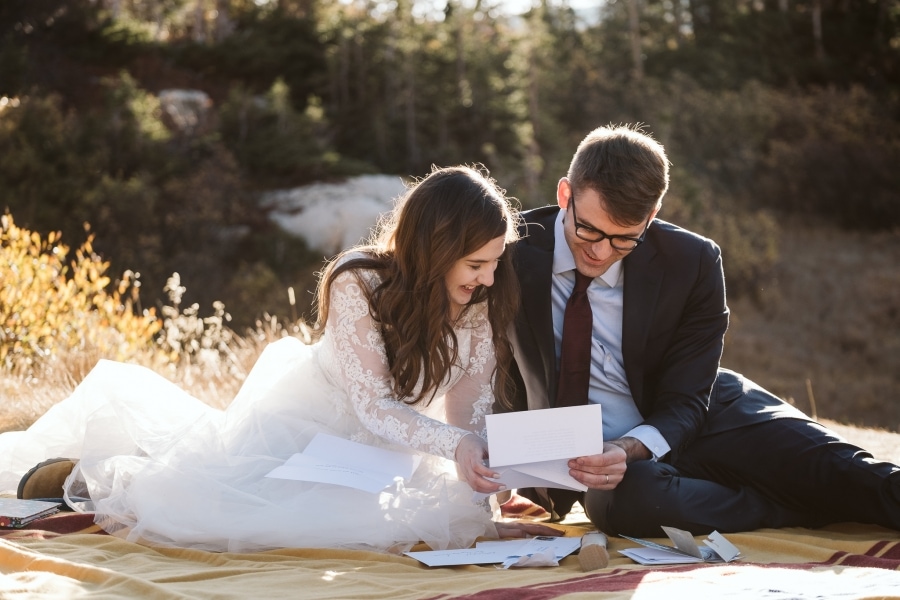
Even if you’re not planning a picnic as part of your adventure elopement, I always recommend that my couples bring a picnic blanket. You’ll want to sit down to sign your marriage license, enjoy a celebratory beverage, read letters from your families, or just take breather after hiking to your destination. With a good picnic blanket, you can sit down anywhere without worrying about getting your outfits dirty. And as a bonus, wool blankets like those from Pendleton double as a cute prop in cold weather, when you can wrap yourselves up in the blanket to stay warm.
My favorite picnic blankets for elopements:
- Pendleton – If you want to use your elopement as an excuse to invest in a high quality blanket that can come along on adventures for the rest of your lives together, you can’t go wrong with Pendleton. Their National Park Blanket series is my favorite.
- Matador – The Matador Pocket Blanket is the perfect option for when you want something to sit on, but don’t wanna carry a heavy wool blanket up a mountain. It folds up tiny, is big enough for two people to sit on, and it’s waterproof. I have a couple of these myself and keep one in every bag and backpack I use.
- Rumpl – Rumpl makes packable puffy blankets that are great both for sitting on and cozying up underneath when it’s cold.
Hydration
Staying hydrated is super, super important – especially here in Colorado where the combination of altitude and dry air can leave you dehydrated much quicker than at sea level. If you’re hiking for your elopement, the best way to stay hydrated is to get a hydration reservoir for your backpack, so that you can easily take sips of water along the way.
Water bottles are best for shorter hikes, since you need to stop to pull one out of your backpack side pocket every time you need a sip of water, and they don’t hold as much water. I personally carry 2L of water (67oz / half a gallon) in a hydration reservoir for any hike over 4 miles round-trip. You always want to carry more water than you need. If you run out of water before the end of your hike, you didn’t pack enough.
Traveling to your elopement destination? Invest in a good reusable bottle before your trip, and it’ll pay itself off by what you save on plastic water bottles during your travels. (And you’ll help save the environment, too!)
My favorite hydration reservoirs and water bottles:
- Osprey – I use the Osprey 3L hydration reservoir, but rarely fill it past 2L. For most day hikes, 2L is plenty to get you through, and you don’t want to be carrying much more weight than necessary.
- Camelback – Camelback’s hydration reservoirs are probably the best known, but I personally like the Osprey design better because it’s easier to fill and clean without making a mess.
- Hydro Flask – I love my 40oz Hydro Flask for keeping beverages cool in summer. I always leave a full water bottle in my car while hiking, and the water is still cold when I get back 10+ hours later even after sitting in a hot car all day.
- EcoVessel – EcoVessel is based in Boulder, and one of my favorite local companies. I have their wine tumblers, and they do a great job of keeping wine cool for plenty long enough for me to finish it. All their products come with a 100 year warranty.
- Kleen Kanteen
Snacks
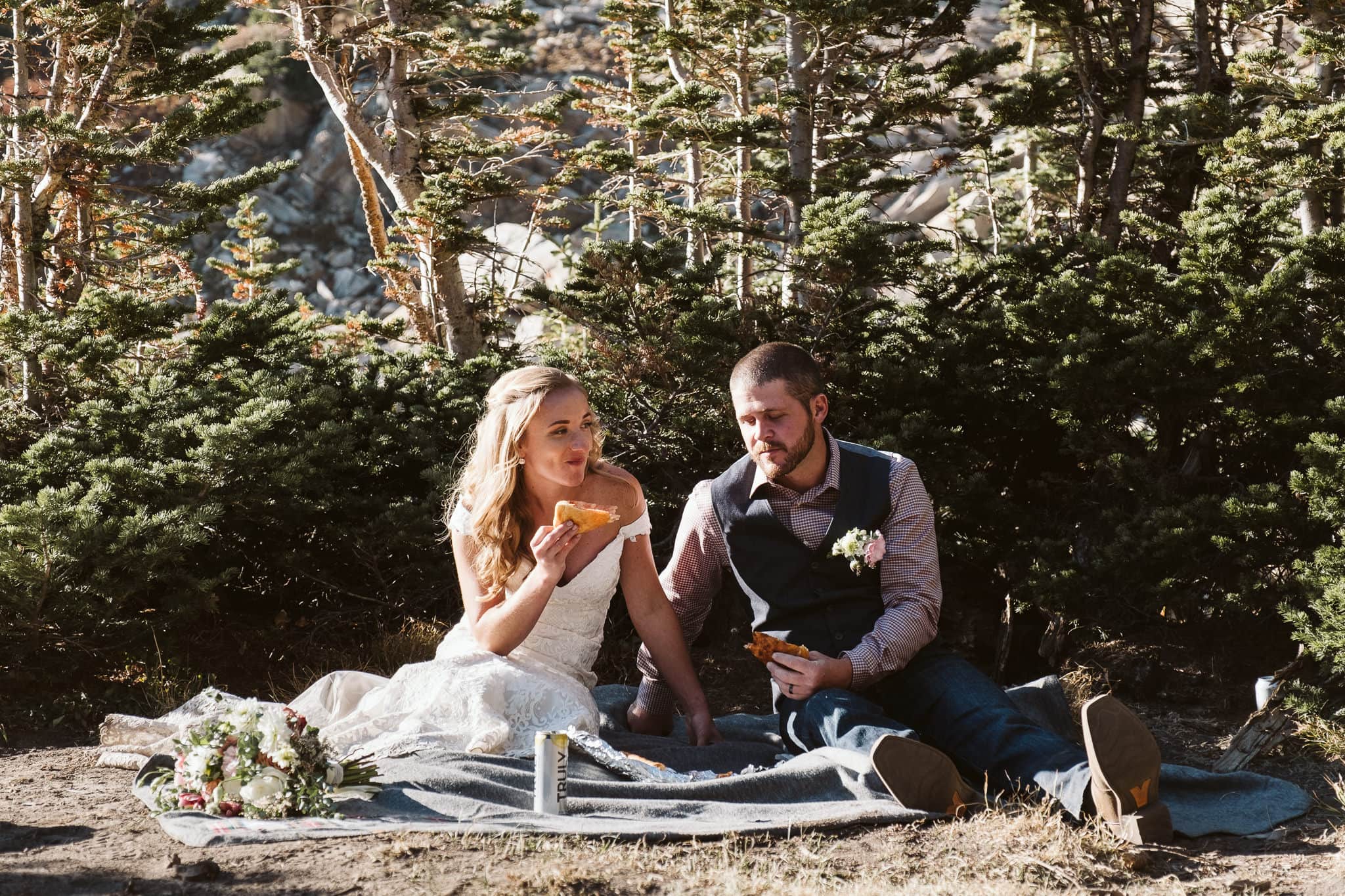
Snacks go into the same category as water, where you always want to bring more than you think you’ll need. Pack snacks like trail mix, granola bars, or energy chews that you can easily eat while hiking. If you’re going to be outdoors for more than a few hours, plan on bringing one or more full meals as well.
Some examples of meals my couples have brought on their elopements include peanut butter and jelly sandwiches, charcuterie boards (pack the pieces individually and put it together at your destination), pizza slices (the best backcountry dinner imho, since it tastes good cold and can easily be wrapped up and packed), thermos with hot soup (perfect in winter), and of course wedding cake slices, cupcakes, cookies, and all the other sweat treats.
If you want to prepare a meal together outdoors, bring a campstove and a backpacking meal pouch or two. These meals just need water and heat, and can be both filling and delicious. I use an MSR WhisperLite backpacking stove, but their PocketRocket stove is another great option.
And if you want to keep food (or drinks) cool while adventuring in nature, you cannot beat YETI coolers. They have small insulated lunch boxes (perfect for bringing charcuterie in your backpack), and bigger hard-sided coolers that could keep your wedding cake or lunch cool in the car while you go on a morning hike.
My favorite hiking snacks and backpacking meals:
- Backpacker’s Pantry – Their Pad Thai and Chana Masala are delicious.
- Mountain House – Classic backpacking meals like Beef Stroganoff and Lasagna.
- Kind bars
- Bobo’s Oat Bars – Boulder based company that makes delicious oat bars and bite-sized snacks.
- Honey Stinger – Steamboat Springs based company that makes yummy energy-waffles, chews, and bars.
- Skratch Labs – I’m on a roll here with the Colorado based companies.. Skratch Labs is also based in Boulder, and makes tasty hydration mixes with real fruit flavors. Perfect if you have a hard time staying hydrated enough by drinking plain water.
- I love packing Justin’s Nut Butter packs along with an apple for a small hiking meal, and often pack gummy bears or sour patch kids to snack on while hiking. (Dry mouth is a real thing at altitude, so sour candies are delicious on the trails.)
Hand warmers
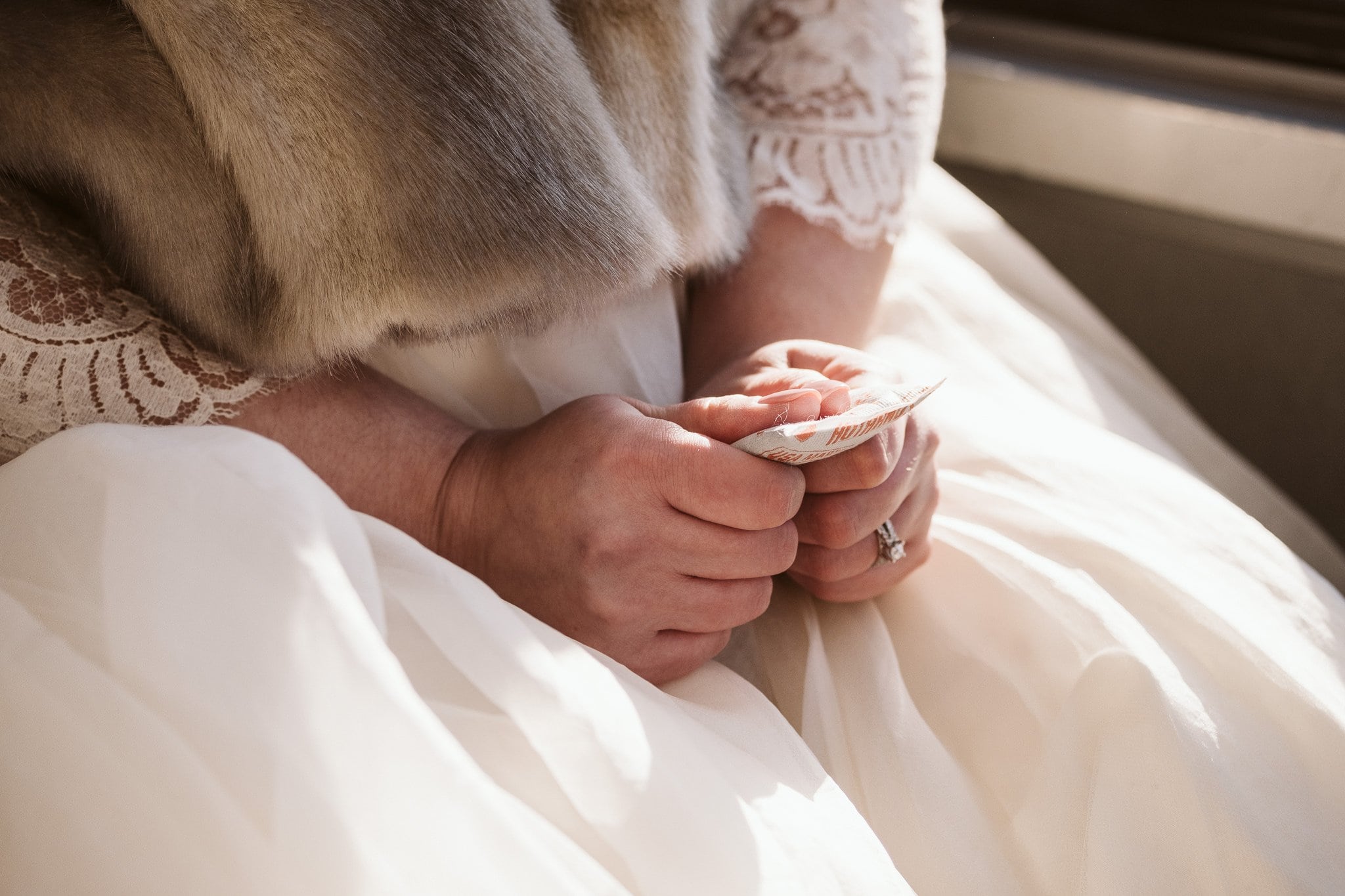
If you’re eloping in winter, hand warmers are an absolute essential piece of gear. You can get the cheap single-use ones that you shake to activate, or invest in battery-powdered ones. (Just make sure they’re fully charged before heading outside, as batteries die quicker when it’s cold.) They even make toe warmers that fit inside your boots, and stick-on body warmers!
Trekking poles
If you have any knee problems at all, trekking poles are a must-have, but they can be great for others, too. I personally like to use trekking poles when I’m hiking in winter, since they help with stability and not slipping and sliding – especially downhill. They’re also great if you’re hiking with a heavy backpack, as they help distribute the weight away from your knees and ankle joints. If you’ve never hiked with poles before and aren’t sure if you want them, I’d recommend borrowing or renting a pair first and taking them for a trial hike so you can see how they feel.
- Black Diamond – I have the Trail Pro trekking poles, but you can get cheaper pairs for as low as $50.
Headlamps

Hiking early in the morning to catch sunrise at an alpine lake, or staying out for sunset on a mountain top before hiking back down in the dark? You’ll need headlamps for sure. Each person should have their own headlamp, to make sure you can see where you’re going and avoid any tripping and falling.
And if you’ve never hiked in the dark before, let me be the first to tell you that it’s the coolest feeling! Hearing the wind in the treetops, birds twittering, wondering if that rustling sound was a squirrel or a bear – you’ll never feel more in tune with nature than when you’re on the trails in the dark. (Seriously. You’ve gotta try it to believe me.)
My favorite headlamps are all from Black Diamond. You can get simple ones like the Astro 250 for under $20, or go more advanced like the Spot 350 for $40. (I have three of the Spot 350s, so that I have two extras for my couples in case they don’t bring their own.) The main thing to look for in a headlamp are dimmable lights – especially if you want to use them for photos.
Micro-spikes or snowshoes
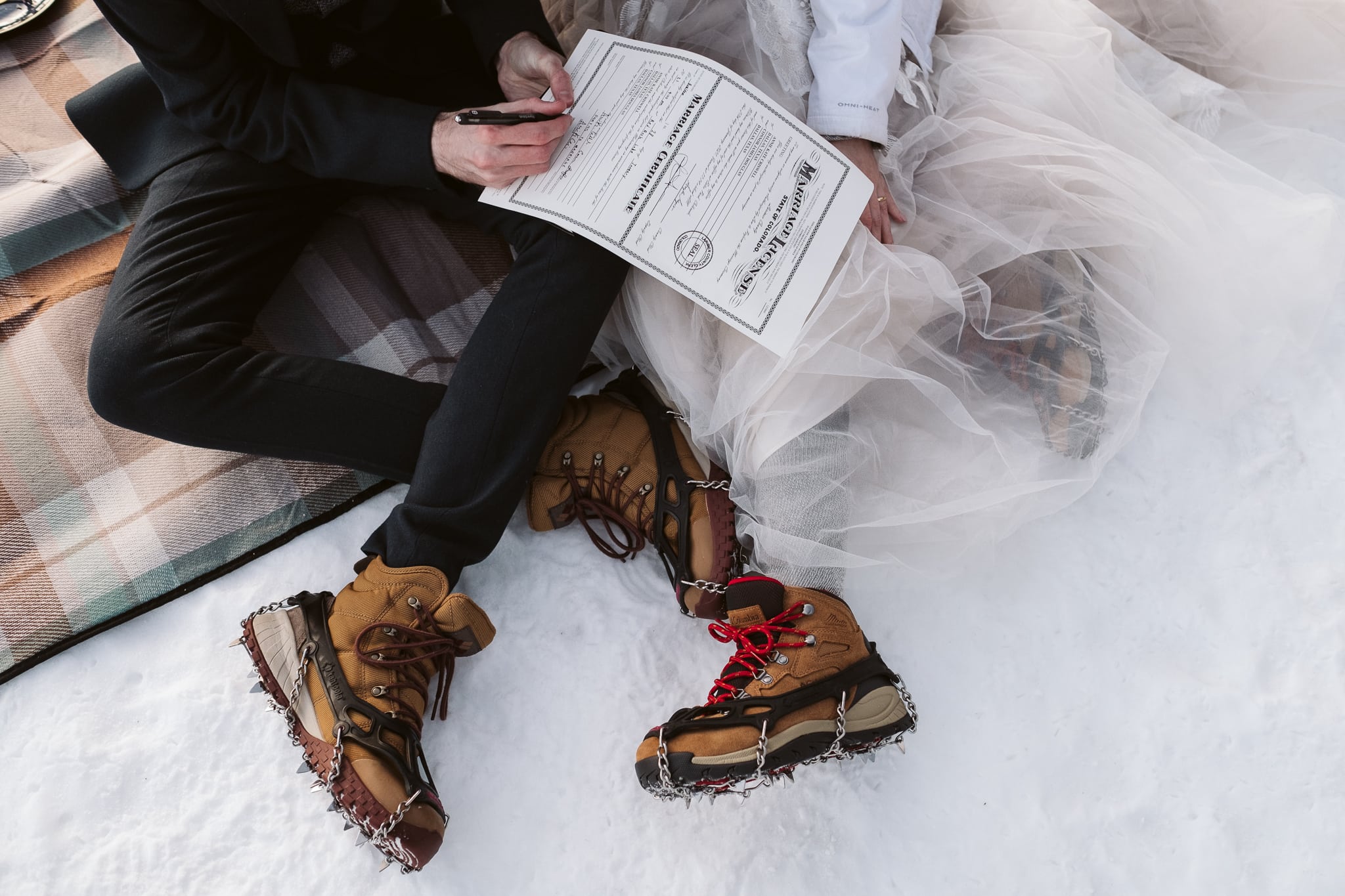
Micro spikes, or traction, is such an essential piece of gear for winter elopements that I actually keep five extra pairs in the trunk of my Subaru all winter long, just in case my couples don’t bring their own. These things go over your boots, and make you feel like a superhuman on snowy and icy conditions. Running across a frozen alpine is no big deal with spikes on.
There are different versions of micro spikes, but the only ones I recommend are Kahtoola Microspikes. Yak-Trax and other “nano spikes” are best for walking your dog on flat sidewalks around the neighborhood – they offer some support, but aren’t nearly tough enough for hiking trails in winter.
If you’re planning a winter hike where the snow could be deep, you’ll need snowshoes. I have the MSR Lightning Ascent snowshoes, which are great for hikes with an incline because of the built in traction and “televators” – a frame you flip up under your heels when going uphill to reduce fatigue. Not planning on using snowshoes more than once? You can rent snowshoes from REI, and many local outfitters.
Portable speaker

Planning on having a first dance in nature? You’ll need a portable bluetooth speaker. Keep it small and lightweight. You don’t need the most powerful speaker for an elopement, as we want to play the music at a level where only we can hear it, and not other hikers in the area. A speaker that clips onto the outside of your backpack is a great choice if you’ll be in an area without many other hikers around, but I personally think it’s annoying to play music on busy trails.
Vow books
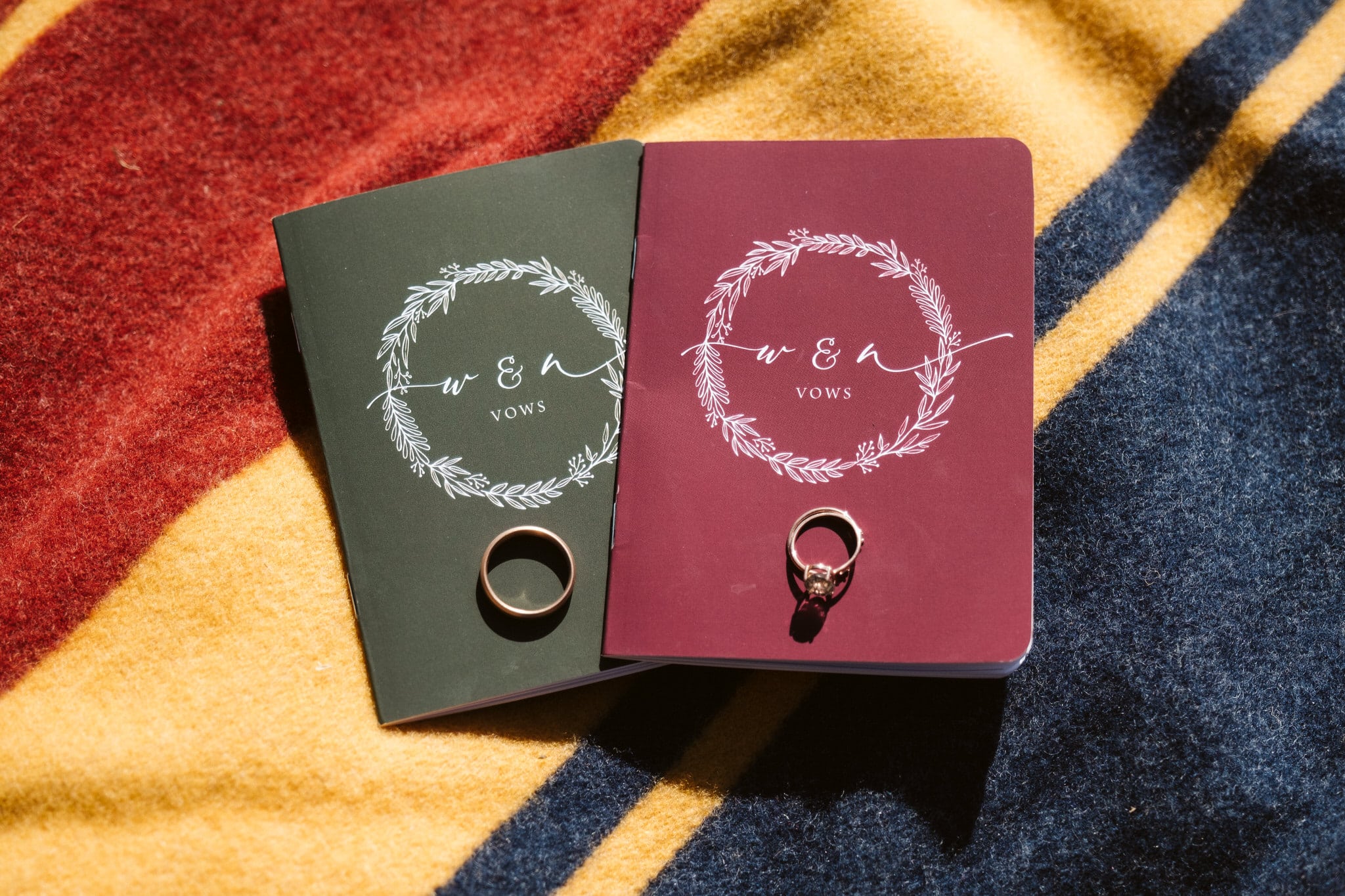
There are tons of options for vow books, whether you want something customized with your names or wedding date or more generic. Etsy is a great place to start with a search for vow books.
Marriage license and pens
When packing your marriage license, you want to avoid folding it or having it get wrinkled inside your backpack. The best solution I’ve seen is to roll it up inside a cardboard packing tube, or an empty paper towel roll if you want to keep it simple. Make sure you pack two pens as well, so you have a backup if the ink dries out on one. Most states ask that you use a pen with black ink to fill out your marriage license.
Navigation
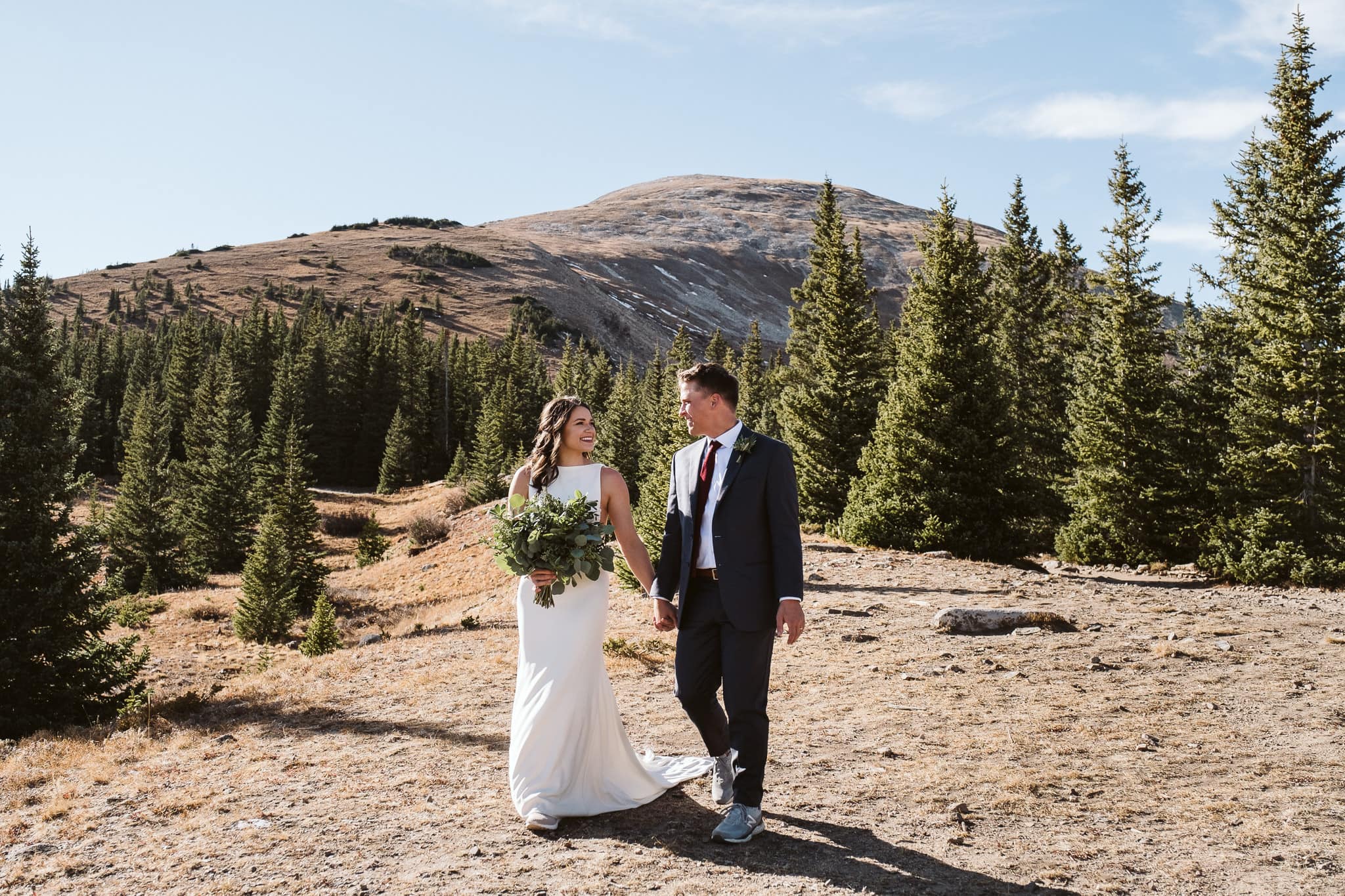
If you want to be extra careful about your trip, you should ideally carry a paper map of the trail or area you’ll be exploring. I personally just use my phone for most hikes, and paper maps for overnight backpacking trips when I’m more likely to run out of battery. I always download Google Maps for offline use since it includes the roads to trailheads, but for hiking trails I prefer AllTrails Pro. AllTrails is a website and app that lets you save hikes, see super specific trail details, and the Pro version lets you download topographic maps and trail directions offline.
Sun protection
This is more important here in Colorado than many other places where the weather is less intense, but make sure you are wearing sun screen before heading out for your adventure elopement. And if your eyes are sensitive to bright light, pack sunglasses too – but try to wear a pair that doesn’t leave marks on your nose or forehead.
Depending on the length and difficulty of your hike or adventure, and your experience with the outdoors, you might also want to add the remaining gear from the Ten Essentials list that I haven’t listed separately: knife, fire (matches, lighter, tinder, and/or camp stove), and shelter (like a lightweight emergency bivy).
Where to buy elopement gear
I’ve added direct links to all my favorite brands and products throughout the guide, so if you prefer to shop online that’s a great place to start browsing. For backpacks and hiking boots especially, you can’t beat the experience of trying on gear in store, so I highly recommend that you head into your local REI and ask for their expert advice.
If you’d like to keep your elopement affordable, and not end up with a bunch of stuff you’ll never use again after the day is over, start by asking friends if they have gear you can borrow. Prioritize buying gear that you’ll use again, and that has to fit you well, like hiking boots and a backpack.
Many larger cities, especially in outdoorsy places like Colorado and the Pacific Northwest, have used outdoor gear retailers where you can buy everything you need at a discounted price. Wilderness Exchange in Denver, The Gearage in Fort Collins, Gearheads Outdoor Store in Moab, Outdoor Gear Exchange in Burlington, Snow Mountain River in Flagstaff, and Wonderland Gear Exchange in Seattle are great options if you’re local to those places, or traveling there for your elopement.
REI also has an outlet store and used gear section on their website, and Patagonia’s Worn Wear is another great way to buy used.
Does every eloping couple need all this gear?
Short answer: no. My recommendations in this post are pretty specific to the types of elopements I photograph here in Colorado: hiking in the backcountry, with no cell service, and a chance of surprise hail storms or snow pretty much any day of the year. If you’re eloping in the woods of PNW or on a beach in Hawaii, your gear needs will be different. Once you have a location picked out for your elopement, your local photographer should be able to give you personalized gear recommendations based on the specific trail and time of year.
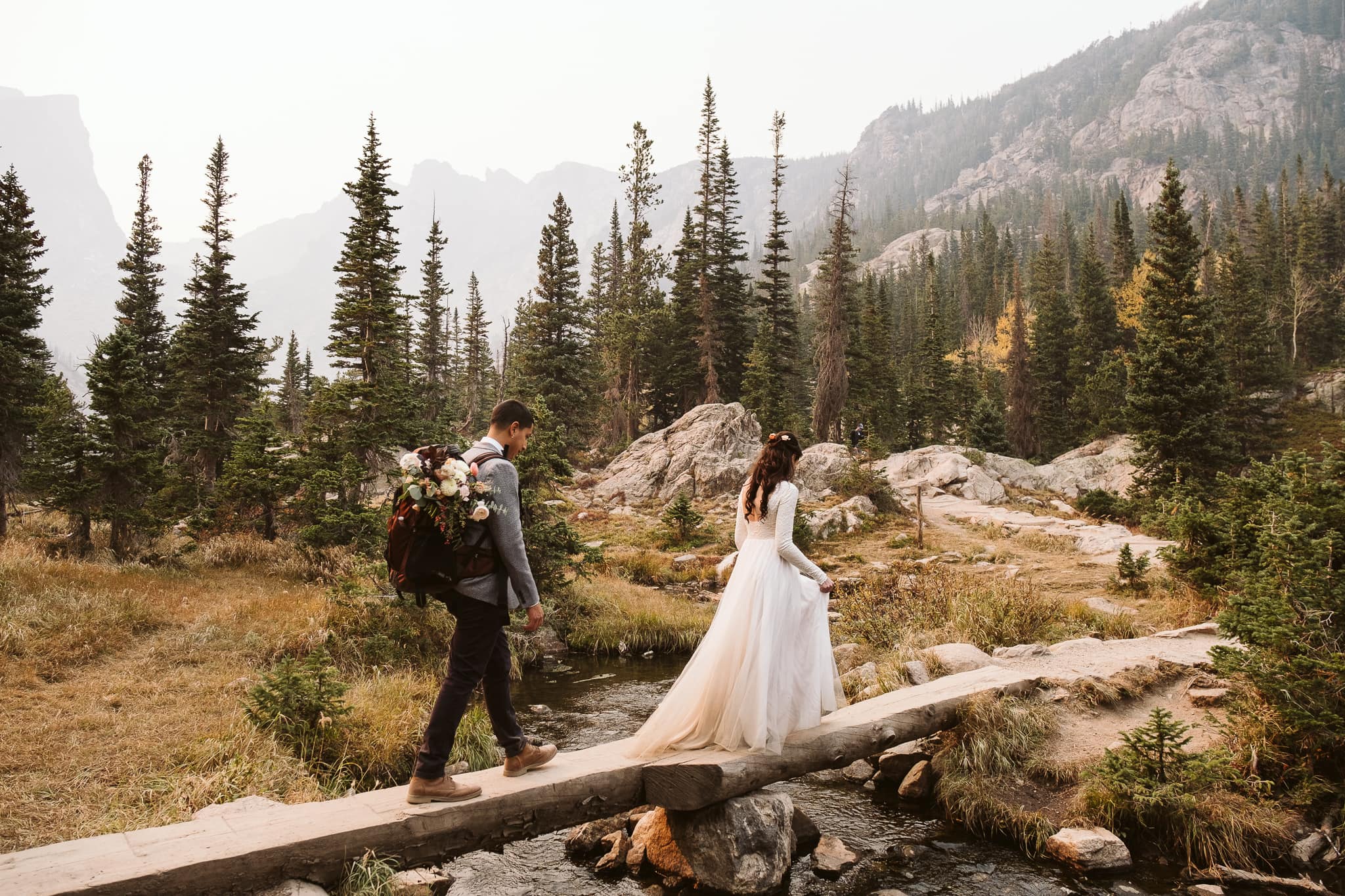
What about gear for elopement photographers?
Photographing elopements comes with very different gear requirements than traditional weddings and portrait photography. You can see all the gear I use to photograph adventure elopements here.

